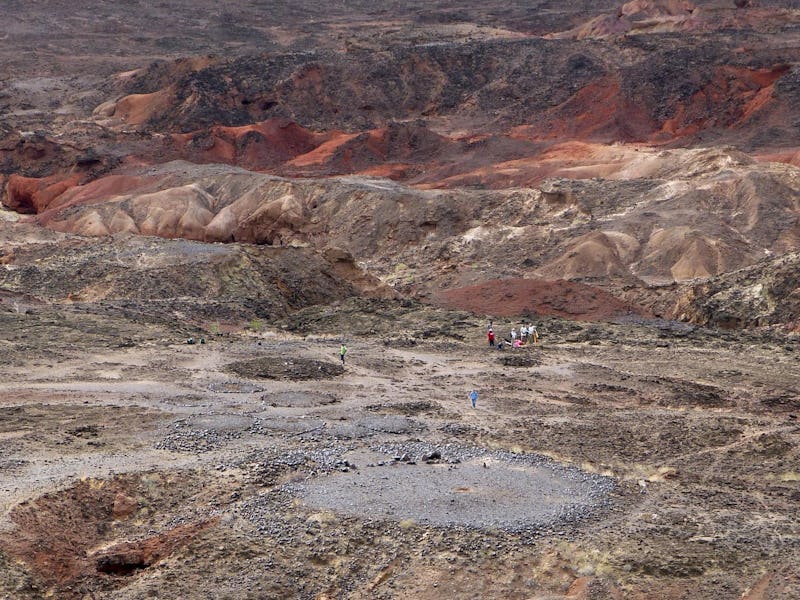Bodies in 5,000-Year-Old Kenyan Cemetery Reveal Ancient Egalitarian Society
"That's a pretty cool story."

The Turkana, a people who live in a sandy expanse of northwestern Kenya, have known about Lothagam North for a long time. In their folklore, the towering pillars that rise from the massive archaeological site were once dancing humans who laughed at a stranger who tried to join their circle. That stranger was actually a vengeful god, and in his embarrassed wrath he turned those dancers into stone. Today, those frozen dancers symbolize something else entirely: As scientists report in a new study, they’re part of the oldest and largest monumental cemetery in eastern Africa.
While archeologists have known about the site since the 1980s, a team of researchers known as the Later Prehistory of West Turkana Project first began excavating the site in 2007. A study released Monday in the Proceedings of the National Academy of Sciences shows that the monumental site — and its builders — are far from the archaeological norm. Typically, large monuments signal to archeologists the presence of a complex society with distinct social classes — much like the highly stratified kingdoms of ancient Egypt. The excavations at Lothagam North, however, showed that the people who built it were roving pastoralists with an extraordinarily egalitarian society.
The sheer number of people who are buried at this site, says study co-author and Stony Brook University research assistant professor Elizabeth Sawchuk, Ph.D., is one of its most exciting aspects. Constructed between 4,300 and 5,000 years ago, it consists of a 30-meter wide platform with a large cavity in its center. On top of the cavity sits stones and the basaltic pillars, and buried beneath it are 580 people, all laid to rest with no indication that any one individual was valued above another.
“They [men, women, babies, and the very elderly] were densely buried in different body positions and orientations, almost as though to maximize the number of people they could fit in the cavity,” Sawchuk tells Inverse.
View of Lothagam North, Kenya. Megaliths, stone circles, and cairns can be seen behind the platform mound.
“This is astounding considering these groups probably had low population density and would have travelled around in small family units and bands,” she continues. “The fact that these sites contain so many people, and that none of these burials were cut off by later interments, suggests that it was very important to the community to bury the dead together in this place.”
Ground-penetrating radar surveys and excavations led Sawchuk and her colleagues to also find highly personalized ornaments buried alongside the deceased. These ornaments, which included stone pendants, beads, and earrings, were spread evenly throughout the cemetery and indicated to the archeologists that the society didn’t have a rigid social hierarchy.
Stone pendants and earrings buried among the dead in Lothagam North.
One of the ornaments, a ground stone palette with a cow’s face delicately carved into it, is “probably going to be the all-time favorite find of my career,” says Sawchuk. Before she and her colleague Steve Goldstein, Ph.D. flipped it over, they thought it was just a rock.
Stone palette with a zoomorphic bovine carving from the communal cemetery of Lothagam North, Kenya.
The excavation of Lothagam North indicates that monuments don’t just reflect societies in which a group in power wields wealth and dominance over another. Here, a people without a social hierarchy took the astounding step to build something for the sake of congregation, remembrance, and the strengthening of social ties. The archeologists believe that the pastoralists also built Lothagam North during a time of extreme change. While it was being built, annual rainfall in the Turkana Basin was decreasing, and nearby Lake Turkana shrunk by fifty percent. Today, that area is a valley of red sandstone; then, it was bountiful land undergoing rapid change.
Sawchuk says that the site is evidence that big upheavals don’t necessarily lead to violence and competition among groups living the same area. As these environmental changes took place, the fisher-hunter-gatherers that lived alongside the lake began to meet and mix with pastoralists, leading to entirely new ways of life and, eventually, a monument for all to honor their dead.
“As everything was changing around them, these early herders responded by creating lasting monuments to bury their dead together,” says Sawchuk. “That’s a pretty cool story.”
These cooperative egalitarians may sound too good to be true — and indeed it’s still not clear who they were, exactly. The researchers know that the people buried at Lothagam North are not related to the Turkana people who currently live in the area, as Turkana oral history documents their move to the region only a few hundred years ago. In an attempt to get a better sense of who they are, Sawchuk’s Ph.D. work partially involves comparing the biology of those buried at the site to those of other skeletons found across eastern Africa. She says those results will be published soon.
“However,” says Sawchuk, “we still don’t know if the pillar-site builders have any living descendants, and where those descendants might be.”